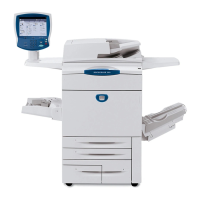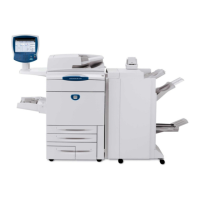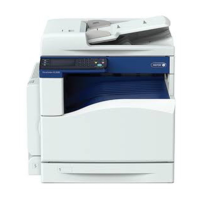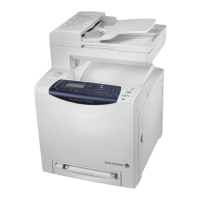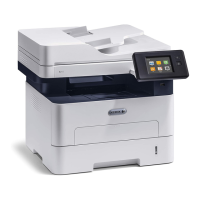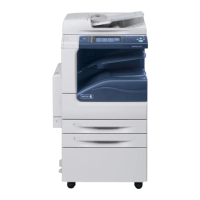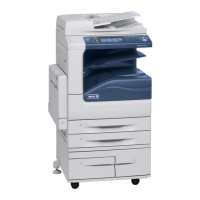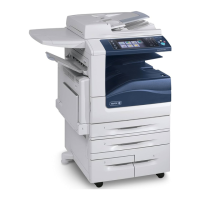1/05
10-131
DocuColor 12/DCCS50
Process Controls
Principles of Operation
Reissue
Process Controls
Overview
The purpose of Process Controls is to maintain consistent image density and color balance.
Control of the image density is more critical for color images then it is for black copies. Slight
variations in any color density (C, M, Y) can result in a significant hue shift in the final color
image.
Process Controls has two primary m
onitoring and cont
rol functions:
•
Electrostatic and ROS LED Quantity Control - The surface electrical potential of Photore-
ceptor Drum monitored by the ESV sensor. And s
etting the intensity of the ROS LED so
that the Electrostatic patch on the Drum is within the target value for the exposed back-
ground charge (Vm).
•
Developability Control - The supply of developer and the control of toner density and gra-
dation on the IBT as monitored by the ADC Sensor.
Electrostatic and ROS LED Quantity Control
The basic purpose of Electrostatic Control is to maint
ain the Photoreceptor Drum unexposed
background voltage (Vh) and the exposed image voltage (Vm) constant over time.
This function monitors and controls the electros
tatic charge level on the Photoreceptor Drum
and the level of exposure to create the latent electrostatic image. This drum charge level is
read by the Electrostatic Voltmeter (ESV). The drum charge is applied by the Charge Corotron,
with the Corotron Wire suppling a constant voltage and the Corotron Grid Bias adjusting the
voltage to various levels in order to maintain a constant background voltage on the drum.
A bac
kground charge (Vh) is
to be maintained by Electrostatic Control at the Photoreceptor
Drum. This is done by adjusting the Charge Corotron Grid Bias (Vg). During setups, Electro-
static Control adjusts the Charge Corotron Grid Bias (Vg) to various levels and reads the
result
in
g Photoreceptor voltage using the Electrostatic Voltmeter (ESV). With a Developer Bias
of -500 VDC, this results in a cleaning field (Vclean) of 150 volts. This cleaning field is the
potential difference which causes toner particles to return to the Developer Roll from the back-
ground areas of the electrostatic latent image.
The exposed im
age charge
(Vm) is the electrostatic voltage level on the Drum image area with
a 50% density. Electrostatic Control is always trying to maintain Vm by adjusting the Laser
Diode power level after the Vh is set.
During the machine Set Up Cycle, target values are established for Charge Corotron Grid volt-
ages and the light quantity of the ROS LED, accounting to both temperature and humidity vari-
ables as sensed by the Environment
al Sens
or (EVN). Once these target values are
established, then the following are set:
• Development Bias for each color
•ASG Bias
• Electrical potential of the ADC Density Patch
The Set Up procedures are as follows:
1.
Setting Target Values: Accounting to the number of Photoreceptor Drum cycles and the
humidity as sensed by the EVN Sensor, the machine sets target values for Drum Surface
electrical potential (Vh and Vm), Development Bias for each color, ASG Bias, and density
of the ADC Patch.
2.
Setting Grid Voltage: The Grid voltage of the Charge Corotron is calculated so that the
Drum surface electrical potential meets the target values as established in step 1.
3.
Setting ROS LED Quantity: An electric potential background voltage (Vh) Patch is created
on the Photoreceptor Drum and read by the ESV Sensor in step 2. The light quantity of
the ROS LED is calculated so that the exposed image voltage (Vm) of that Patch meets
the target values as established in step 1.
4.
Correction of ASG Bias: The ASG Bias target values for each color established in step
one is corrected by the actual readout value of the Patch on the Drum.
5.
Setting the Target Value for the ADC Density Patch: The target electrical potential of the
ADC Density Patch, as read by the ADC Sensor on the IBT Assembly is done.
Developability Control
This function monitors and controls the dispensi
ng of developer in order to control the density
of the developed image. The monitoring is done from two inputs:
•
Automatic Density Control (ADC) - This measures the density of the developed reflective
patch on the IBT by the ADC Sensor. The Gain of the ADC Sensor is adjusted during the
Set Up cycle.
•
Image Count Dispensing Control (ICDC) - This provides a pixel count for an image to help
determine the demand for the various color developers. This is done during the copy
cycle.
The supply of developer to the Xerographics process
is cont
rolled by Image Coverage Dis-
pense Control (ICDC), and the reflective readings off the IBT Belt by the ADC Sensor. The fol-
lowing steps are performed for the Toner Supply Control:
1. ADC Sensor set up for the Automatic Gain Control (AGC)
• The ADC Sensor reads the reflective density of t
he clean IBT Belt (non-developed).
• This density reading is check in LUT to be in range or the high and low limit values.
• The gain of the ADC sensor is adjusted when the density readings are too high or
low.
2. I
mage Coverage Dispense Control (ICDC) is implemented during t
he copying cycle.
• When the ROS Laser exposes the Photoreceptor Drum,
the number of pixels is cal-
culated for each color.
• These pixel counts is converted to a rotation t
ime of the Developer Dispense Motor
for each color.
3. ADC Set Up Cycle is performed by reading the actual reflective density of the developed
pat
ch on the IBT Belt. This reading is used to calculate the demand for the Developer.
• An ADC Patch is formed on the IBT in a location between the copying images. All
colors are laid down
in the same patch and each is read by the ADC Sensor.
• The densities for the ADC Patch on the Belt is read and calculated against the read-
ing in the non-developed part of the IBT (clean IBT).
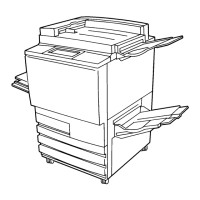
